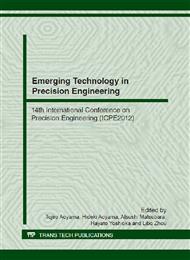p.414
p.420
p.433
p.439
p.445
p.451
p.457
p.463
p.469
On the Extraction of Milling Tools Out of Shrink Fit Chucks
Abstract:
Thermal shrink fit chucks are widely used in high performance machining where excellent concentricity and high torque transmission are required. It was reported that in those milling operations, severe damage of tools, workpieces, and also machine tools occurs due to an extraction of the milling tool out of the shrink fit chuck during the process. Although, theoretically the interference fit assembly should withstand certain process forces, milling tools are apparently pulled out under special process conditions. The resulting increase of the cutting depth often leads to tool overload and breakage. So far, the phenomenon of tool extraction could not be explained. This paper presents an experimental approach of the investigation of the phenomenon of axial tool extraction. Therefore, a unique type of test rig for main spindles and tool interfaces is used. Experimental investigations on dynamic force and torque combinations leading to tool extraction are described. Results show, that the holding force is not only affected by geometrical parameters of the shrink fit chuck, but also by the applied dynamic load.
Info:
Periodical:
Pages:
445-450
Citation:
Online since:
November 2012
Authors:
Keywords:
Price:
Сopyright:
© 2012 Trans Tech Publications Ltd. All Rights Reserved
Share:
Citation:


